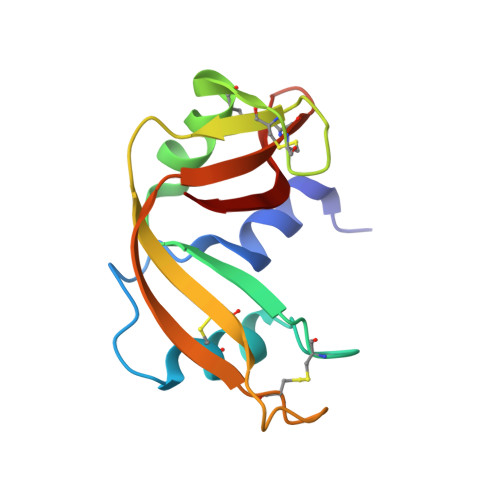Productive and nonproductive binding to ribonuclease A: X-ray structure of two complexes with uridylyl(2',5')guanosine.
Vitagliano, L., Merlino, A., Zagari, A., Mazzarella, L.(2000) Protein Sci 9: 1217-1225
- PubMed: 10892814
- DOI: https://doi.org/10.1110/ps.9.6.1217
- Primary Citation of Related Structures:
1EOS, 1EOW - PubMed Abstract:
Guanine-containing mono- and dinucleotides bind to the active site of ribonuclease A in a nonproductive mode (retro-binding) (Aguilar CF, Thomas PJ, Mills A, Moss DS, Palmer RA. 1992. J Mol Biol 224:265-267). Guanine binds to the highly specific pyrimidine site by forming hydrogen bonds with Thr45 and with the sulfate anion located in the P1 site. To investigate the influence of the anion present in the P1 site on retro-binding, we determined the structure of two new complexes of RNase A with uridylyl(2',5')guanosine obtained by soaking two different forms of pre-grown RNase A crystals. In one case, RNase A was crystallized without removing the sulfate anion strongly bound to the active site; in the other, the protein was first equilibrated with a basic solution to displace the anion from the P1 site. The X-ray structures of the complexes with and without sulfate in P1 were refined using diffraction data up to 1.8 A (R-factor 0.192) and 2.0 A (R-factor 0.178), respectively. The binding mode of the substrate analogue to the protein differs markedly in the two complexes. When the sulfate is located in P1, we observe retro-binding; whereas when the anion is removed from the active site, the uridine is productively bound at the B1 site. In the productive complex, the electron density is very well defined for the uridine moiety, whereas the downstream guanine is disordered. This finding indicates that the interactions of guanine in the B2 site are rather weak and that this site is essentially adenine preferring. In this crystal form, there are two molecules per asymmetric unit, and due to crystal packing, only the active site of one molecule is accessible to the ligand. Thus, in the same crystal we have a ligand-bound and a ligand-free RNase A molecule. The comparison of these two structures furnishes a detailed and reliable picture of the structural alterations induced by the binding of the substrate. These results provide structural information to support the hypotheses on the role of RNase A active site residues that have recently emerged from site-directed mutagenesis studies.
- Centro di Studio di Biocristallografia, CNR, Universita' degli Studi di Napoli Federico II, Italy.
Organizational Affiliation:


















